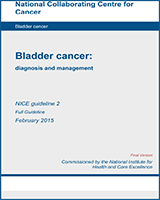NCBI Bookshelf. A service of the National Library of Medicine, National Institutes of Health.
National Collaborating Centre for Cancer (UK). Bladder Cancer: Diagnosis and Management. London: National Institute for Health and Care Excellence (NICE); 2015 Feb. (NICE Guideline, No. 2.)
- What are the causative and contributory factors underlying the persistently very low levels of reported patient satisfaction for bladder cancer?
- Is primary radical cystectomy more effective than primary intravesical BCG in high-risk non-muscle-invasive bladder cancer, in terms of quality of life and cancer-specific outcomes?
- In people with high-risk non-muscle-invasive bladder cancer, are these follow-up regimens equally effective in terms of identification of progression, cost effectiveness and health-related quality of life?
- Cystoscopic follow-up at 3, 6, 12, 18, 24, 36 and 48 months, and then annually, interspersed with non-invasive urinary tests.
- Cystoscopic follow-up at 3, 6, 9, 12, 15, 18, 21, 24, 30, 36, 42 and 48 months, and then annually thereafter.
- In patients with muscle-invasive bladder cancer suitable for radical treatment, does the use of biomarkers enable patients to select more effective treatment, and improve their outcomes compared with treatment selected without biomarkers?
- Is symptom-based review as effective as scheduled follow-up for people treated with radical cystectomy or radical radiotherapy for organ-confined muscle-invasive bladder cancer? Outcomes of interest are overall survival, health-related quality of life, resource use and cost.
- Key research recommendations - Bladder CancerKey research recommendations - Bladder Cancer
Your browsing activity is empty.
Activity recording is turned off.
See more...
